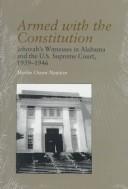| Listing 1 - 10 of 14 | << page >> |
Sort by
|

ISBN: 1280335505 0585453144 020345877X 9780585453149 0203460588 9780203460580 9780203458778 9780415266093 0415266092 9780415266109 0415266106 9781280335501 0415266092 9781134501472 9781134501519 9781134501526 113450151X Year: 2002 Publisher: London New York Routledge
Abstract | Keywords | Export | Availability | Bookmark
 Loading...
Loading...Choose an application
- Reference Manager
- EndNote
- RefWorks (Direct export to RefWorks)
This is the first major study of the enigmatic religious society. By examining the Jehovah's Witnesses' dramatic recent expansion, Andrew Holden reveals the dependency of their quasi-totalitarian movement on the physical and cultural resources have brought about the privatization of religion, the erosion of community, and the separation of 'fact' from faith.

ISBN: 3486564048 3486594435 1306780764 Year: 1999 Publisher: De Gruyter
Abstract | Keywords | Export | Availability | Bookmark
 Loading...
Loading...Choose an application
- Reference Manager
- EndNote
- RefWorks (Direct export to RefWorks)
Bis heute gehören die Zeugen Jehovas zu den weitgehend vergessenen Opfern des NS-Regimes. Sie wurden bereits Mitte 1933 und von da an mit unerbittlicher Härte bekämpft. Keine andere Religionsgemeinschaft hat mit einer vergleichbaren Geschlossenheit und Unbeugsamkeit dem nationalsozialistischen Druck widerstanden. Der Bekennermut der ""Bibelforscher"" beschäftigte zeitweilig höchste Stellen in Justiz, Polizei und SS. Sie waren die einzige Gruppe, die ungeachtet drohender Todesstrafe geschlossen den Kriegsdienst verweigerte. Die Auswertung bislang unbekannter Archivalien, Interviews mit Überlebe
Jehovah's Witnesses --- National socialism --- Nazi persecution. --- Religious aspects. --- Germany --- Religion --- Nazi persecution of Jehovah's Witnesses --- Persecution --- World War, 1939-1945 --- Atrocities
Book
ISBN: 1442664614 9781442664616 Year: 1984 Publisher: Toronto, [Ontario] ; Buffalo, [New York] ; London, [England] : University of Toronto Press,
Abstract | Keywords | Export | Availability | Bookmark
 Loading...
Loading...Choose an application
- Reference Manager
- EndNote
- RefWorks (Direct export to RefWorks)
In 1984 George Orwell described a future theocracy that demanded unity at all costs, and in which all independent thought would be eradicated. According to the authors of this book, such a theocracy now exists. They describe how, in an increasingly restrained 'New World Society', Jehovah's Witnesses busily go about the business of warning the world that their God, Jehovah, will act soon to destroy all who oppose him and his organization. For them 1984 appears to be the current unofficial deadline for Armageddon, for they believe that God promised that the generation that saw the beginning of world distress (starting with World War I in 1914) would not pass away before the end came. A biblical generation is seventy years. 1914 + 70 = 1984. Convinced that the world Is due to end, they have given up their independence to the central theocracy. The Bottings, both Witnesses, can and do answer the questions everyone asks about this sect. They examine its history, the ways in which history itself has been interpreted in the light of bible prophecy, the basic beliefs or 'symbols' in which Witnesses are required to put their faith, and the dynamics of conversion and indoctrination. They also reveal why Jehovah's Witnesses turn away from their calling by the thousands and how the sect effects a 'mental-regulating' of youth as choice is taken away from children at a very young age. The sect is not only subject to forces of dissidence and disaffection from its membership, it has also been subject to a major rift within its headquarters. This event and what was done about it are also described. The authors conclude this serious, concerned, probing but readable study with an exploration of parallels between the contemporary Jehovah's Witness sect and the world described by George Orwell in 1984.
Jehovah's Witnesses. --- Christian sects --- Orwell, George, --- Watch Tower Bible and Tract Society of Pennsylvania. --- Nineteen eighty-four (Orwell, George) --- Watch Tower Society --- Watch Tower Bible & Tract Society of Pennsylvania --- Jehovah's Witnesses --- Watchtower Bible and Tract Society of New York --- International Bible Students Association --- Zion's Watch Tower Tract Society --- Orwell's Nineteen eighty-four (Orwell, George) --- 1984 (Orwell, George)
Book
ISBN: 1137396059 1137396040 9781137396051 Year: 2018 Publisher: London : Palgrave Macmillan UK : Imprint: Palgrave Macmillan,
Abstract | Keywords | Export | Availability | Bookmark
 Loading...
Loading...Choose an application
- Reference Manager
- EndNote
- RefWorks (Direct export to RefWorks)
This book examines the tensions between Jehovah’s Witnesses and government authorities, civic organisations, established churches and the broader public generated by the Watch Tower Society’s teachings. Witnesses originated in the 1870s as small, loose-knit groups calling themselves Bible Students. Today, there are some eight million Witnesses worldwide, all actively engaged in evangelism. The author analyses issues that have brought them global visibility and even notoriety, including political neutrality, public ministry, blood transfusion, and anti-ecumenism. It also explores anti-Witness campaigns, from media portrayals of the community as marginal and exotic to the anti-cult movement. Focusing on varied historical, ideological and national contexts, the book argues that Witnesses have had a defining influence on conceptions of religious tolerance in the modern world.
History. --- Religion --- Civilization --- Social history. --- Social History. --- History of Religion. --- Cultural History. --- Jehovah's Witnesses. --- Christian sects --- Religion-History. --- Civilization-History. --- Descriptive sociology --- Social conditions --- Social history --- History --- Sociology --- Religion—History. --- Civilization—History.
Book
ISBN: 9780521881470 0521881471 9780511581038 9781107684508 9780511580710 0511580711 0511581033 9780511579882 0511579888 9780511580390 0511580398 9780511579141 0511579144 0511698526 1107199670 1107684501 1282302930 9786612302930 0511578407 9780511698521 9781107199675 9781282302938 6612302933 9780511578403 Year: 2009 Publisher: Cambridge, UK New York Cambridge University Press
Abstract | Keywords | Export | Availability | Bookmark
 Loading...
Loading...Choose an application
- Reference Manager
- EndNote
- RefWorks (Direct export to RefWorks)
Schism (from the Greek 'to split') refers to a group that breaks away from another, usually larger organisation and forms a new organisation. Though the term is typically confined to religious schisms, it can be extended to other kinds of breakaway groups. Because schisms emerge out of controversies, the term has negative connotations. Though they are an important component of many analyses, schisms in general have not been subjected to systematic analysis. This volume provides the first book-length study of religious schisms as a general phenomenon. Some chapters examine specific case studies while others provide surveys of the history of schisms within larger religious traditions, such as Islam and Buddhism. Other chapters are more theoretically focused. Examples are drawn from a wide variety of different traditions and geographical areas, from early Mediterranean Christianity to modern Japanese New Religions, and from the Jehovah's Witnesses to Neo-Pagans.
Religion --- Schism. --- Schisme --- History. --- Histoire --- Religious history --- Apostasy --- Heresy --- Sects --- Arts and Humanities --- religious schisms --- religious groups --- religious controversy --- religous traditions --- Islam --- Buddhism --- Mediterranean Christianity --- Japanese new religions --- Jehovah's Witnesses --- Neopaganism --- Japan --- Japanese new religious movements

ISBN: 0585253536 9780585253534 0817307362 9780817307363 0817312285 9780817312282 Year: 1995 Publisher: Tuscaloosa, Ala. University of Alabama Press
Abstract | Keywords | Export | Availability | Bookmark
 Loading...
Loading...Choose an application
- Reference Manager
- EndNote
- RefWorks (Direct export to RefWorks)
Freedom of religion --- Jehovah's Witnesses --- Constitutional amendments --- Law - U.S. --- Law, Politics & Government --- Constitutional Law - U.S. --- Christian sects --- History. --- Legal status, laws, etc. --- History --- Legal status, laws, etc --- Marsh, Grace --- Jones, Rosco --- Trials, litigation, etc. --- United States.
Book
ISBN: 1283616297 9786613928740 0810870541 9780810870543 9781283616294 9780810862692 0810862697 9780810868915 0810868911 Year: 2009 Publisher: Lanham, Md. Scarecrow Press
Abstract | Keywords | Export | Availability | Bookmark
 Loading...
Loading...Choose an application
- Reference Manager
- EndNote
- RefWorks (Direct export to RefWorks)
The theme of prophecy, the doctrine of the 144,000, end-time calculations, Armageddon, and the Witnesses' denial of hell are all considered in The A to Z of Jehovah's Witnesses, which contains a chronology, an introductory essay, a bibliography, and 250 cross-referenced dictionary entries relating to key people and concepts.
Jehovah's Witnesses --- Christian sects --- History --- religion --- history --- Charles Taze Russell --- the Watch Tower Society --- Franklin Rutherford --- door-to-door Evangelism --- doctrine --- Armageddon --- dictionary --- end-time calculations --- blood transfusion
Book
ISBN: 1282233939 9786613811677 0803271441 9780803271449 0803271425 9780803271425 Year: 2012 Publisher: Lincoln University of Nebraska Press
Abstract | Keywords | Export | Availability | Bookmark
 Loading...
Loading...Choose an application
- Reference Manager
- EndNote
- RefWorks (Direct export to RefWorks)
English teachers --- Jehovah's Witnesses --- Abused children --- Children of divorced parents --- Divorced parents' children --- Divorced parents --- Adult children of divorced parents --- Children of single parents --- Battered children --- Child abuse victims --- Maltreated children --- Victims of child abuse --- Children --- Victims of crimes --- Adult child abuse victims --- Child abuse --- Christian sects --- Castro, Joy --- Family. --- Childhood and youth.
Book
ISBN: 0228012465 9780228012474 0228012473 9780228012467 9780228010548 0228010543 9780228010555 0228010551 Year: 2022 Publisher: Montreal Kingston London Chicago
Abstract | Keywords | Export | Availability | Bookmark
 Loading...
Loading...Choose an application
- Reference Manager
- EndNote
- RefWorks (Direct export to RefWorks)
In June 1949 the Soviet state arrested seven farmers from the village of Bila Tserkva. Not wealthy or powerful, the men were unknown outside their community, and few had ever heard of their small, isolated village on the southwestern border of Soviet Ukraine. Nevertheless, the state decided they were dangerous traitors who threatened to undermine public order, and a regional court sentenced them to twenty-five years of imprisonment for treason.In To Make a Village Soviet Emily Baran explores why a powerful state singled out these individuals for removal from society. Bila Tserkva had to become a space in which Soviet laws and institutions reigned supreme, yet Sovietization was an aspiration as much it was a reality. The arrested men belonged to a small and misunderstood religious minority, the Jehovah’s Witnesses, and both Witnesses and their neighbours challenged the government’s attempts to fully integrate the village into socialist society. Drawing from the case file and interviews with the families of survivors, Baran argues that what happened in Bila Tserkva demonstrates the sheer ambition of the state’s plans for the Sovietization of borderland communities.A compelling history, To Make a Village Soviet looks to Bila Tserkva to explore the power and the limits of state control – and the possibilities created by communities that resist assimilation.
Government, Resistance to --- Jehovah's Witnesses --- History --- Persecutions --- Armageddon. --- Article 58. --- Bible Students. --- Gulag. --- Jehovahs Witnesses. --- KGB. --- Protestant. --- Romanian. --- Russia. --- Soviet Union. --- Sovietization. --- Stalin. --- Subcarpathia. --- Tisa River. --- Transcarpathia. --- USSR. --- Ukraine. --- WW2. --- Watchtower. --- World War II. --- Zakarpattia. --- Zakatpate. --- archives. --- borderlands. --- collectivization. --- communism. --- evangelism. --- freedom. --- investigation. --- persecution. --- propaganda. --- proselytism. --- religion. --- repression. --- rural. --- scapegoats. --- sects. --- secularization. --- security. --- socialism. --- surveillance.
Book
ISBN: 1479831131 1479896705 9781479831135 9781479896707 Year: 2019 Publisher: New York New York University Press
Abstract | Keywords | Export | Availability | Bookmark
 Loading...
Loading...Choose an application
- Reference Manager
- EndNote
- RefWorks (Direct export to RefWorks)
The eight-decade story of a New York neighborhood In 1940, the Metropolitan Life Insurance Company opened a planned community in the East Bronx, New York. A model of what the neighborhood would become was first displayed to an excited public at the 1939 World's Fair. Parkchester was celebrated as a "city within a city," offering many of the attractions and comforts of suburbia, but without the transportation issues that plagued commuters who trekked into New York City every day. This new neighborhood initially constituted a desirable alternative to inner city neighborhoods for white ethnic groups with the means to leave their Depression-era homes. In this bucolic environment within Gotham, the Irish and Italian Catholics, white Protestants and Jews lived together rather harmoniously. In Parkchester, Jeffrey S. Gurock explains how and why a "get along" spirit prevailed in Parkchester and marked a turning point in ethnic relations in the city.Gurock is also attuned to, and documents fully, the egregious side to the neighborhood's early history. Until the late 1960s, Parkchester was off-limits to African Americans and Latinos. He is also sensitive to the processes of integration that took place once the community was opened to all and explains why transition was made without significant turmoil and violence that marked integration in other parts of the city. This eight decade history takes Parkchester's tale up to the present day and indicates that while the neighborhood is today predominantly African American and Latino, and home to immigrants from all over the world, the spirit of conviviality still prevails on its East Bronx streets.As a child of Parkchester himself, Gurock couples his critical expertise as leading scholar of New York City's history with an insider's insight in producing a thoughtful, nuanced understanding of ethnic and race relations in the city.
New York (State) --- Parkchester (New York, N.Y.) --- History. --- Race relations --- African Americans. --- Bronx history. --- Bronx. --- Integration. --- Irish. --- Italians. --- Jehovah’s Witnesses. --- Jews. --- Metropolitan Life Insurance Corporation. --- NAACP. --- NYC neighborhoods. --- NYC. --- New York City. --- New York history. --- New York neighborhoods. --- New York. --- Third World immigration. --- Urban League. --- World War II. --- assimilation. --- condominiums. --- desegregation. --- ethnicity. --- gentrification. --- home front. --- housing. --- immigration. --- interfaith. --- neighborhoods. --- race. --- segregation. --- suburbanization. --- suburbia. --- urban renewal. --- women activists. --- youth gangs.
| Listing 1 - 10 of 14 | << page >> |
Sort by
|

 Search
Search Feedback
Feedback About UniCat
About UniCat  Help
Help News
News